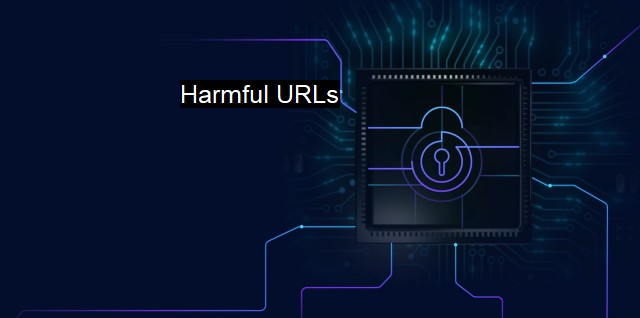What are Harmful URLs?
Mitigating the Threat of Harmful URLs: Safeguarding Digital Privacy in the Internet-Driven Era
Harmful URLs, commonly referred to as malicious URLs, are internet links that lead to webpages hosting malware, phishing scams, or any other security threat. These URLs are often embedded in spam emails, text messages, or social media posts and are crafted enticingly to attract unsuspecting users.These harmful URLs are one of the most common forms of digital threats capable of causing significant damage to users, organizations, and industries globally. These URLs, often deceivingly simple and safe-looking, conform to the standard web address structure but have an inherent, malicious intent to harm. They redirect users to potentially hazardous sites, typically set up by cyber hackers, to trick users into divulging sensitive personal information or unknowingly download harmful malware onto their devices.
The plethora of harmful URLs is a critical issue that affects internet users worldwide daily. According to a 2017-based research by Webroot, a single day might witness almost 1.5 million new phishing websites. These fast-evolving cyber fraud techniques are getting increasingly sophisticated, thus posing enormous challenges to cybersecurity experts.
There are various ways harmful URLs can execute damage. Some URLs participate in phishing schemes, involving tricking users to type in sensitive information such as credit card details or login credentials on a site disguised as an authentic website. They can misrepresent fonts or letter orders, utilizing common pianos like "flipping" letters or using a zero to replace an "O". Some URLs might aim to inject malware or viruses onto a device or network. The malicious software can steal data, damage software, interfere with user control, or even render the device unresponsive.
Harmful URLs exploit venerabilities in programs or software to conduct drive-by downloads, where malicious software is automatically downloaded onto the device upon simply visiting a website. Similarly, harmful URLs can sometimes also lead to websites that host exploit kits, which are automated threats exploiting application vulnerabilities to spread malware. Exploit kits determine the right combination of these vulnerabilities depending on the digital environment of specific users.
Sophisticated techniques used by malicious actors make the early detection of harmful URLs challenging. It can range from URL shortening, a concealing trick making the harmful URL less visible, to the inclusion of trusted domain names in the URL to trick users into clicking the link. Despite these challenges, security companies and researchers invest substantial time and resources in creating heuristics, accurate models, and algorithms that can detect these harmful URLs.
Antivirus solutions and robust cybersecurity practices can both play a significant role in mitigating the risk posed by harmful URLs. Industry-leading antivirus solutions are commonly equipped with real-time scanning capabilities, automatically scanning a URL before the site is loaded. Users are warned when a URL is flagged as potentially harmful, giving the user the option to return safely.
a well-informed, precautionary browsing practice is a user's first line of defense against harmful URLs. Ensuring URLs are thoroughly examined before clicking on them, identifying any suspicious elements within the webpage structure, and enabling two-factor authentication where available, are all practices that can limit exposure to harmful URLs.
Harmful URLs are an ongoing battle in our connected world. The wide array of tactics used by cybercriminals can leave many unsuspected users prone to potentially dangerous engagements. The fight against harmful URLs, therefore, should combine the implementation of robust antivirus solutions, consistent system updates, and awareness of browsing security guidelines, alongside internet users maintaining cautious and informed cybersecurity practices.

Harmful URLs FAQs
What are harmful URLs, and why are they a cybersecurity concern?
Harmful URLs are links that lead to websites containing malicious content, such as malware or phishing scams. These URLs can compromise the security of a user's device and even lead to identity theft or financial fraud.How can I identify if a URL is harmful or not?
One way to identify a harmful URL is by checking the domain name for misspellings or unusual characters. Additionally, if the URL has a long string of random characters or appears to be from an unknown source, it may be best to avoid clicking on it altogether.What can I do to protect myself from harmful URLs?
The best way to protect yourself from harmful URLs is to use a reliable antivirus software that can detect and block malicious links. Additionally, it's important to be cautious when clicking on links in emails or unknown websites and to avoid downloading files from untrusted sources.What should I do if I accidentally clicked on a harmful URL?
If you accidentally clicked on a harmful URL, it's important to disconnect your device from the internet and run a full virus scan. If you suspect any unauthorized activity on your device, such as a fraudulent transaction or identity theft, you should report it to your bank or credit card company immediately.| | A | | | B | | | C | | | D | | | E | | | F | | | G | | | H | | | I | | | J | | | K | | | L | | | M | |
| | N | | | O | | | P | | | Q | | | R | | | S | | | T | | | U | | | V | | | W | | | X | | | Y | | | Z | |
| | 1 | | | 2 | | | 3 | | | 4 | | | 7 | | | 8 | | |||||||